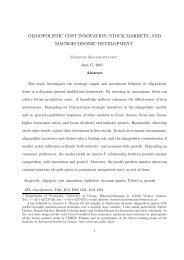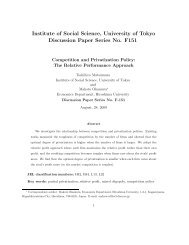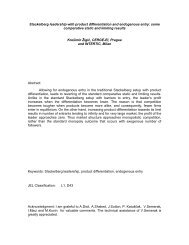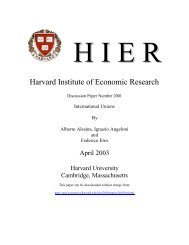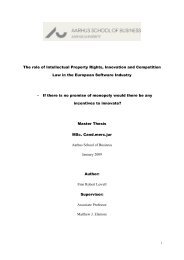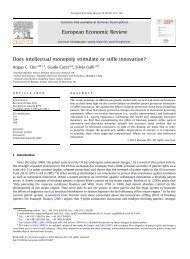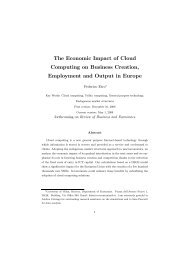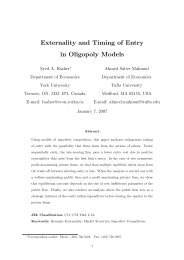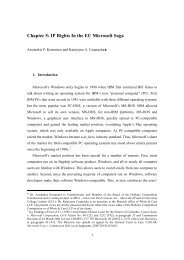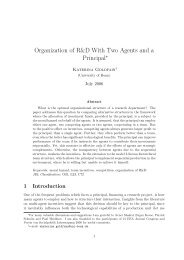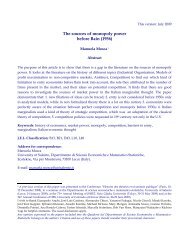The EU Approach to Abuse of Dominance - Intertic
The EU Approach to Abuse of Dominance - Intertic
The EU Approach to Abuse of Dominance - Intertic
You also want an ePaper? Increase the reach of your titles
YUMPU automatically turns print PDFs into web optimized ePapers that Google loves.
agree <strong>to</strong> exclusive dealing or tying arrangements and abusive behaviour in aftermarkets (markets for<br />
“secondary” products, such as spare parts, consumables or servicing, which are bought after the<br />
purchase <strong>of</strong> the primary product; e.g., <strong>to</strong>ner cartridges for printers, replacement parts for household<br />
appliances or maintenance for computer equipment) 22 and mainly refusals <strong>to</strong> supply, that is “situations<br />
where a dominant company denies a buyer access <strong>to</strong> an input in order <strong>to</strong> exclude that buyer from<br />
participating in an economic activity” (# 209). <strong>The</strong> Discussion Paper distinguishes three situations: where<br />
an existing supply relationship is terminated, where there is a refusal <strong>to</strong> commence supplying an input,<br />
including situations where this input is covered by IPRs, and where the input is information necessary<br />
for interoperability.<br />
<strong>The</strong> Discussion Paper states that four conditions have <strong>to</strong> be fulfilled in order <strong>to</strong> find the<br />
termination <strong>of</strong> such a supply relationship <strong>to</strong> be abusive: (i) the behaviour must be properly characterised<br />
as a termination <strong>of</strong> the supply arrangement; (ii) the refusing undertaking must be dominant; (iii) the<br />
refusal must be likely <strong>to</strong> have a negative effect on competition; and (iv) the refusal must not be justified<br />
objectively or by efficiencies. <strong>The</strong>re is no reference <strong>to</strong> the need <strong>to</strong> show that the input is “indispensable”.<br />
This implies that the termination <strong>of</strong> an existing supply relationship is more likely <strong>to</strong> be abusive than a<br />
refusal <strong>to</strong> supply a new cus<strong>to</strong>mer. Assuming dominance and a termination <strong>of</strong> a supply arrangement are<br />
22 <strong>The</strong> Discussion Paper has a short part on this subject. When an after-market is “brand-specific” (i.e. where<br />
secondary products for one brand <strong>of</strong> primary product cannot be used with another brand <strong>of</strong> primary product), the<br />
supplier may have a very large share <strong>of</strong> that after-market, but this does not necessarily imply that the supplier<br />
enjoys market power, as the relationship between the primary market and the after-market may be such as <strong>to</strong><br />
effectively restrain the supplier’s conduct on the after-market (e.g., a supplier’s charging high after-market prices<br />
may adversely affect its sales on the primary product market). <strong>The</strong> examination <strong>of</strong> after-markets accordingly<br />
focuses on how the relationship between the primary market and the after-market impacts on whether the supplier<br />
holds a dominant position on the aftermarket and the fac<strong>to</strong>rs that will be taken in<strong>to</strong> account by the Commission in<br />
this assessment. <strong>The</strong> Discussion Paper also draws a distinction between those cus<strong>to</strong>mers that may purchase the<br />
primary product in the future and those cus<strong>to</strong>mers that have already purchased the primary product. Competition<br />
on the primary market may protect future cus<strong>to</strong>mers from potentially harmful conduct by the supplier on the<br />
aftermarket, but may not protect existing owners <strong>of</strong> the primary products from harm if the supplier changes his<br />
commercial policy on the after-market (e.g., by raising prices). <strong>The</strong> key <strong>to</strong> assessing whether competition on the<br />
primary market will protect future cus<strong>to</strong>mers is the extent <strong>to</strong> which future cus<strong>to</strong>mers make “life cycle” pricing<br />
decisions, by taking after-market prices in<strong>to</strong> account in their decision <strong>to</strong> purchase products on the primary market.<br />
However, competition on the primary market may not restrain a supplier’s conduct on the after-market,<br />
particularly with regard <strong>to</strong> existing cus<strong>to</strong>mers <strong>of</strong> the primary product who are effectively “tied in” <strong>to</strong> purchasing<br />
the after-market product. <strong>The</strong> supplier may change its commercial policy on the after-market (e.g., through raising<br />
prices) <strong>to</strong> take advantage <strong>of</strong> the installed base <strong>of</strong> existing cus<strong>to</strong>mers effectively “tied in” <strong>to</strong> purchasing the aftermarket<br />
product (so-called “installed base opportunism”).<br />
21



